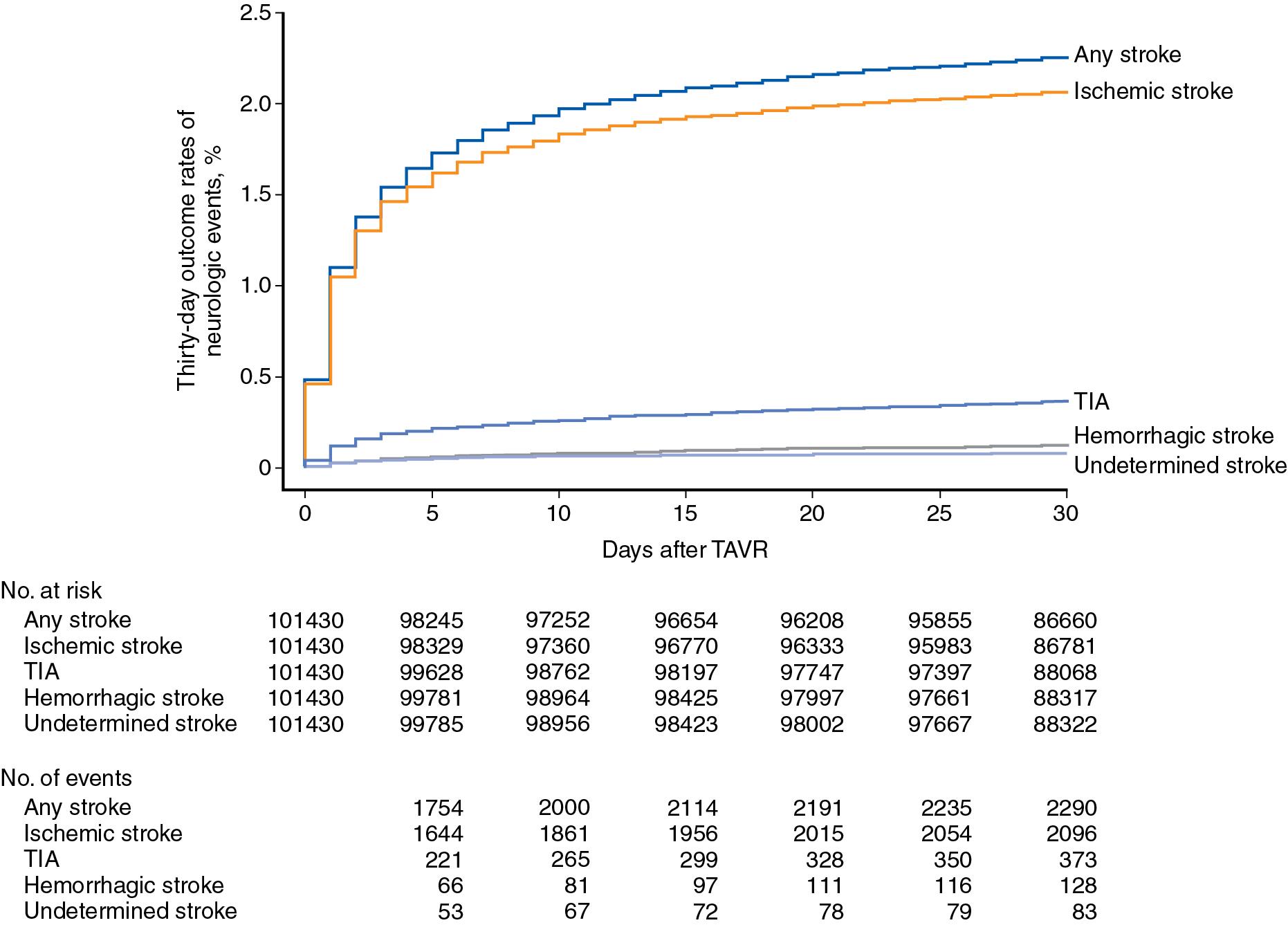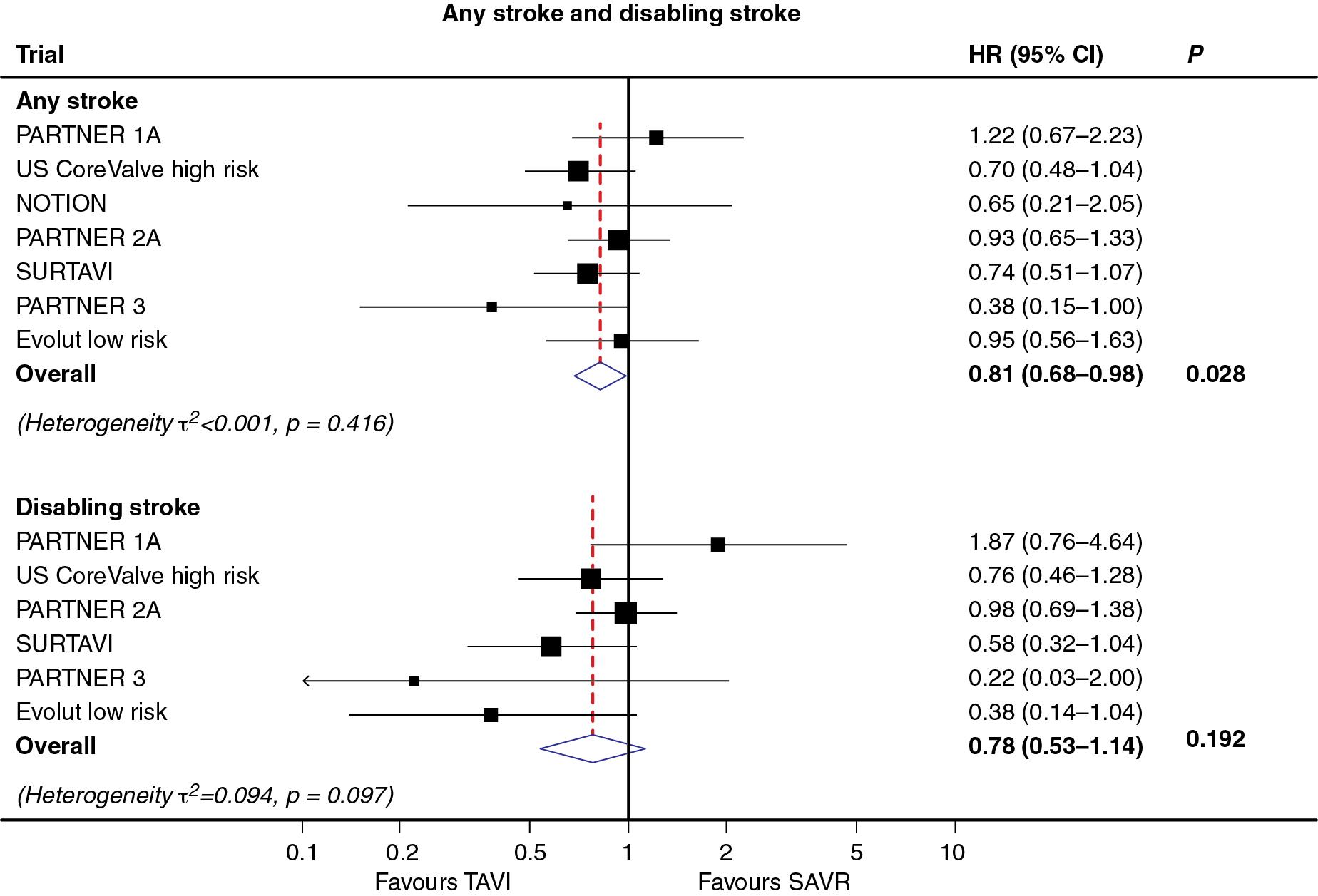Physical Address
304 North Cardinal St.
Dorchester Center, MA 02124
Aortic stenosis is the most common valvular heart disease in the geriatric age group. Transcatheter aortic valve implantation (TAVI) has become the standard of care and is superior to conventional surgery. The indication for TAVI has extended from prohibitive risk to low-risk individuals. TAVI has a survival benefit compared with conventional surgery with a hazard ratio (HR) of 0.88 (95% confidence interval [CI] 0.78–0.99, Fig. 9.1 ). TAVI was also associated with a lower incidence of stroke compared with conventional surgery. ,

Stroke is a dreaded complication and the incidence of 30-day stroke has been constant at around 2.3%. Stroke is also an independent predictor of mortality with an HR of 6.1. Despite the significant improvement in procedural volume, expertise, and device technology, stroke continues to be a fatal/disabling complication. Stroke negates the survival benefit of TAVI and significantly reduces the quality of life. It is essential to prevent a stroke, especially when the indication for TAVI has been extended to the low- and intermediate-risk cohort of patients. This was the rationale for the development of cerebral protection devices (CPDs) to reduce the risk of stroke perioperatively. This chapter covers the entire spectrum of devices and the available data on their use.
The risk of stroke after TAVI was evaluated in a meta-analysis of 53 studies with 10,037 patients. The incidence of major stroke at 30 days after TAVI was 2.9% ± 1.8%. At 12 months, stroke/transient ischemic attack rate was 5.2% ± 3.4%. The mean 30-day mortality rate after stroke was greater than 3.5 times more than those without stroke. Huded et al. reported US data (November 9, 2011, to May 31, 2017) from 101,430 patients undergoing TAVI from the transcatheter valve therapies registry; 778 individuals were excluded as they were discharged to other acute hospitals, to hospice, or were discharged against medical advice. The rate of stroke at 30 days was 2.3%, and the rate of transient ischemic attack at 30 days was 0.4%; 48.9% happened within the first 24 hours and 68.4% within 3 days after TAVI ( Fig. 9.2 ). There was no relationship between the incidence of stroke and access site or anticoagulant/antiplatelet strategy. The mortality was found to be sixfold higher in patients with stroke compared with the patients who did not have a stroke after TAVI (HR: 6.1, 95% CI: 5.4–6.8).

The mechanism of stroke after TAVI is thought to be due to atheroembolic or thromboembolic events. Furthermore, the majority (85%) of the strokes occur within 7 days after TAVI. Some prominent predictors of stroke after TAVI are patient related (female gender, atrial fibrillation, prior stroke, prior TIA, peripheral arterial disease, hypertension, porcelain aorta, carotid stenosis, and chronic kidney disease) and procedure related (postdilation, valve repositioning, Bioprosthetic or native Aortic Scallop Intentional Laceration to prevent Iatrogenic Coronary Artery obstruction [BASILICA]), alternative access, general anesthesia, and self-expanding TAVI devices). , Strokes primarily occur during the procedure as a result of wire/catheter manipulation; device traversing the aortic arch, resulting in disruption of atheroma and embolization of calcific debris while crossing the aortic valve; balloon aortic valvuloplasty; or valve deployment/postdilation. The rate of stroke with balloon postdilation is higher compared with those without postdilation. , To prevent postdilation accurate aortic annular measurement on cardiac computed tomography and subsequent appropriate valve selection are essential, because post-TAVI paravalvular leak caused by an undersized valve propels the need for postdilation. If the activated clotting time (ACT) is subtherapeutic, a thrombus can form on wires/devices during TAVI. The therapeutic ACT should be maintained around 250 to 300 seconds with heparin. On the other hand, a supratherapeutic ACT along with severe periprocedural hypertension can lead to hemorrhagic stroke. Bivalirudin has been compared with heparin in a small randomized trial that demonstrated no significant differences in cerebral embolization after TAVI. , Global cerebral ischemia caused by periprocedural hypotension (rapid pacing during valve deployment/postdilation, anesthetics) is a rare cause of stroke after TAVI. Table 9.1 lists the mechanisms behind stroke in TAVI patients. There is emerging evidence to suggest that clinically silent magnetic resonance imaging (MRI) lesions have been linked to poor cognitive function and neurodegenerative disorders such as Alzheimer’s/vascular dementia. , Despite all aforementioned factors, stroke remains an unpredictable complication of TAVI. Procedural modifications are unlikely to prevent stroke because there are many unpredictable parts of the procedure. CPD can only prevent the embolization of aortic or valvular atherosclerotic plaques during TAVI. CPD can be classified into filters and deflectors. Based on the mechanism these devices can capture or deflect the emboli.
| TEMPORAL RELATIONSHIP TO TAVI | PERIPROCEDURAL | POSTPROCEDURE | |||
|---|---|---|---|---|---|
| Mechanism | Atheroembolism | Global Hypoperfusion | Hemorrhagic | Thromboembolic | Hemorrhagic |
| Etiology |
|
|
Anticoagulation | Atrial fibrillation |
|
The rationale for using CPD for all patients undergoing TAVI is that this is the predominant cause of stroke after TAVI.
Become a Clinical Tree membership for Full access and enjoy Unlimited articles
If you are a member. Log in here